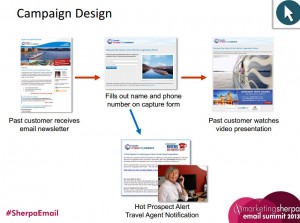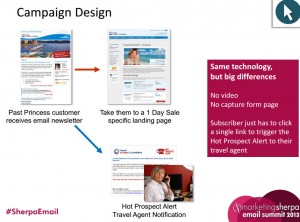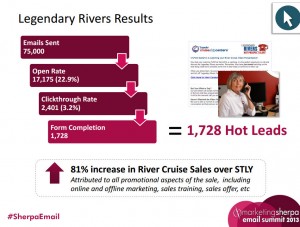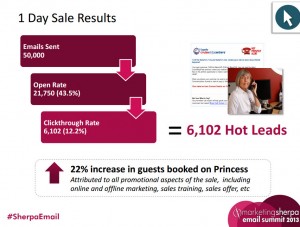Lead Generation Optimization: How Expedia CruiseShipCenters’ increased previous customer conversions 22% by removing its lead capture form
Optimizing form fields in emails can be tricky as sales and marketing departments don’t always agree on how to create an effective lead flow process that captures important customer information while minimizing elements of friction.
So, today’s MarketingSherpa Blog post will share two case studies featured at MarketingSherpa Email Summit 2013 and how one marketing team increased its conversion rate 22% by removing its capture form. Our goal is to share with you some real-world email campaigns you can use to aid your lead generation optimization effort.
First, let’s get some backstory on the role segmentation played in these case studies …
According to Dave Mossop, Manager of Interactive Marketing, Expedia CruiseShipCenters, segmenting between prospects and return customers early on in the campaign was key to allowing the team to offer more relevant content in its messaging.
“We did a very simple split of prospects versus customers and that alone gives you enough information to talk to these audiences very differently,” Dave explained.
By segmenting between prospects and return customers, the team was able to deliver a greater relevance for:
- Price points – Lower for new prospects and higher for return customers
- Itineraries – Specific destinations for new prospects and a broader range of destinations for return customers
- Information – Answer first time cruise information for new prospects and explain the benefit of “Why book with us?”
- Special offers – Exclusive bonus offers for prior customers
“As our team grew, we started going one level deeper by going to customer segments,” Dave explained.
Additional segmentation of past customers allowed the team to:
- Focus messaging, sales offers and itineraries
- Discover upsell and cross sell opportunities
- Prevent down-selling to luxury cruise clients
The team took its segmentation efforts even further by grouping past customers based on previous cruise lines. Expedia CruiseShipCenters discovered past customers were likely to book on the same cruise line again.
By understanding past customer behaviors, the team was also able to:
- Promote cruise line loyalty program offers and exclusives
- Write content from perspective of experience
“We see phenomenal results as we get completely relevant and completely personal with the customer we have this data on,” Dave concluded. “Personalization makes a difference, but who we send to matters even more.”
Legendary Rivers case study
The next challenge for Dave’s team was to determine if they could use its behavioral analytics insights to identify potential sales leads in a niche market in its industry – river cruises.
Here are some research notes on the email campaign …
Background: Engage past customer to learn more about river cruising, a niche segment of the cruise industry growing in popularity
Objective: Generate a qualified lead to their travel agent
Primary Research Question: Is this past customer interested in learning more about river cruising?
Campaign design
Dave introduced this campaign by emphasizing the difference between river cruises – the company’s niche product – and sea cruises – its traditional offering.
“No one really knows what river cruises are, so we wanted to help paint the picture and get some leads out if it as well,” Dave said.
 Dave explained the layout for the legendary rivers email campaign was pretty straightforward. The design was as follows:
Dave explained the layout for the legendary rivers email campaign was pretty straightforward. The design was as follows:
- Past customers receive an email newsletter.
- From there, they are directed to a lead capture form where they are asked for name and phone number. The lead capture form information was a trigger event that notified their travel agent.
- From the capture form, a previous customer is directed to a 10-minute video presentation on river cruising.
“The magic here was in the middle step,” Dave declared. “It notified our sales force of travel agents that a past customer had just filled out their form.”
The notification given to travel agents contained a link to a previous customer profile in Expedia CruiseShipCenter’s CRM system providing agents with contact information, purchase history and additional links to a sample call script and the video.
Results
The email newsletter was sent to 75,000 past customers and resulted in an open rate of 22.9% and a clickthrough rate of 3.2%, with a form completion rate of 72% and a total of 1,728 leads generated through the efforts of Dave and his team.
The overall campaign was a success as river cruise sales saw an increase of 81% from the same time last year.
“We were able to sell river cruises because of this process,” Dave said.
One-day sale case study
Similar to the Legendary Rivers campaign, the one-day sale email campaign sought to leverage the customer behavior analytics.
Remember Dave mentioned earlier past customers were likely to book on the same cruise line again?
What would happen if Dave and his team removed the lead capture form altogether and built an email campaign based on exclusive cruise lines sales offers to past customers?
“What we wanted to do here was to figure out if we could generate a qualified lead to our agents with just a click,” Dave explained.
Let’s take a look at the research notes for this case study …
Background: Create a sense of urgency around our exclusive sale, featuring newly released itineraries from our most popular cruise line
Objective(s): Generate a qualified lead to their travel agent with one click and actively promote outbound calling among their travel agents
Primary Research Question: Does a click translate into a lead?
Campaign design
The one-day sale campaign utilized the CRM system’s data with the most significant difference being the removal of the capture form and video.
 For this campaign, users would:
For this campaign, users would:
- Receive email newsletters that alerted previous customers of new itineraries on cruiselines they had previously traveled on. The user click was also a trigger event that notified travel agents.
- From the click, users were directed to a landing page giving specifics on the offer.
Dave also emphasized removing the capture form and video was a saving in production costs.
Results
The email newsletter was sent to 50,000 past customers and resulted in an open rate of 43.5% and a clickthrough rate of 12.2%, totaling an impressive 6,102 leads generated without a capture form or video
“This really allowed the building of a one-on-one relationship between the travel agent and the customer,” Dave explained.
What you need to understand
Dave offered some key takeaways from the two case studies:
- Use segmentation to speak differently to different audiences.
- Focus on building relationships, not just on getting sales through personalizing sender information content and links.
- Customers prefer to do business with someone they feel they know, rather than a nameless corporate entity.
The most important takeaway of all – strive to send quality leads to your salesforce over quantity by being relevant to your customers and getting personal with them.
Related Resources:
Lead Gen Form Optimization: Why a lower conversion rate can be a good thing
Lead Generation Test: How adding urgency increased conversion rate by 6%
Lead Capture Optimized: 201% increase in captured leads with clearer value proposition
Categories: Lead Generation conversion rate optimization, Email Marketing, email optimization, lead generation optimization, list segmentation, outbound marketing optimization











